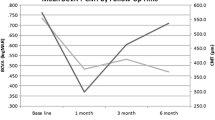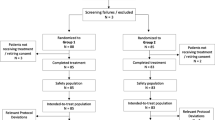Abstract
Purpose
To advance therapy for the treatment of concurrent uveitis and post-cataract surgical inflammation; we evaluated pharmacokinetics and pharmacodynamics of Bioerodible Dexamethasone Implant (BDI) containing 0.3 mg of dexamethasone (DXM) in Concanavalin A (Con A) induced uveitis followed by phacoemulsification in New Zealand White (NZW) rabbits.
Methods
The BDI was implanted in the inferior fornix of the capsular bag after intravitreal injection of Con A and ensuing phacoemulsification in NZW rabbits; standard-of-care topical 0.1% dexamethasone drops served as control. DXM was quantified by liquid chromatography-tandem mass spectrometry and pharmacokinetics of DXM in disease vs. healthy eyes was compared. All eyes were assessed clinically using slit lamp biomicroscopy and Draize scoring scale. Retinal thickness and histological analyses were performed to evaluate retinal edema, inflammation and implant biocompatibility respectively.
Results
In Con A-induced inflammatory uveitic cataract model the BDI controlled anterior and posterior segment inflammation as well as retinal thickening more effectively than topical drops. The exposure (AUC0–t) of DXM with BDI is superior in all ocular tissues, while topical drops did not achieve therapeutic posterior segment levels and did not control inflammation nor prevent retinal edema and architectural disruption.
Conclusions
Our results demonstrate the superiority of the BDI in suppressing Con A-induced inflammation and retinal edema in NZW rabbits and highlight the need for sustained bidirectional delivery of potent anti-inflammatory agents for 5 to 6 weeks to optimize clinical outcomes.








Similar content being viewed by others
Abbreviations
- BDI:
-
Bioerodible dexamethasone implant
- BQL:
-
Below quantification limit
- CME:
-
Cystoid macular edema
- Con A:
-
Concanavalin A
- DXM:
-
Dexamethasone
- EtO:
-
Ethylene oxide gas
- GC-MS:
-
Gas chromatography mass spectrometry
- HPLC:
-
High performance liquid chromatography
- HPMC:
-
Hydroxypropyl methylcellulose
- LC-MS/MS:
-
Liquid chromatography tandem mass spectrometry
- LLOQ:
-
Lower limit of quantification
- MWCO:
-
Molecular weight cut off
- NSAIDs:
-
Non-steroidal anti-inflammatory drugs
- NZW:
-
New Zealand white rabbits
- PCO:
-
Posterior capsule opacification
- PLGA:
-
Poly(d,l-lactide-co-glycolide)
- PVA:
-
Polyvinyl alcohol
- SD-OCT:
-
Spectral domain optical coherence tomography
References
Lens and Cataract (revised). In: Bobrow J, editor. 2008–2009 Basic and clinical science course. San Fransisco: American Academy of Ophthalmology; 2008.
Hankinson SE. Epidemiology of age-related cataract. In: Albert DM, Jakobiec FA, Azar DT, Gragoudas ES, editors. Principles and Practice of Ophthalmology. Philadelphia: W. B. Saunders Company; 2000. p. 511–21.
Erie JC, Baratz KH, Hodge DO, Schleck CD, Burke JP. Incidence of cataract surgery from 1980 through 2004: 25-year population-based study. J Cataract Refract Surg. 2007;33(7):1273–7.
Wright PL, Wilkinson CP, Balyeat HD, Popham J, Reinke M. Angiographic cystoid macular edema after posterior chamber lens implantation. Arch Ophthalmol. 1988;106(6):740–4.
Miyake K, Masuda K, Shirato S, Oshika T, Eguchi K, Hoshi H, et al. Comparison of diclofenac and fluorometholone in preventing cystoid macular edema after small incision cataract surgery: a multicentered prospective trial. Jpn J Ophthalmol. 2000;44(1):58–67.
Simone JN, Whitacre MM. Effects of anti-inflammatory drugs following cataract extraction. Curr Opin Ophthalmol. 2001;12(1):63–7.
Adamis AP, Shima DT. The role of vascular endothelial growth factor in ocular health and disease. Retina. 2005;25(2):111–8.
Tejwani S, Murthy S, Sangwan VS. Cataract extraction outcomes in patients with Fuchs’ heterochromic cyclitis. J Cataract Refract Surg. 2006;32(10):1678–82.
Roesel M, Tappeiner C, Heinz C, Koch JM, Heiligenhaus A. Comparison between intravitreal and orbital floor triamcinolone acetonide after phacoemulsification in patients with endogenous uveitis. Am J Ophthalmol. 2009;147(3):406–12.
Hermann MM, Ustundag C, Diestelhorst M. Electronic compliance monitoring of topical treatment after ophthalmic surgery. Int Ophthalmol. 2010;30(4):385–90.
Okeke CO, Quigley HA, Jampel HD, Ying GS, Plyler RJ, Jiang Y, et al. Interventions improve poor adherence with once daily glaucoma medications in electronically monitored patients. Ophthalmology. 2009;116(12):2286–93.
Chennamaneni SR, Mamalis C, Archer B, Oakey Z, Ambati BK. Development of a novel bioerodible dexamethasone implant for uveitis and postoperative cataract inflammation. J Control Release. 2013;167(1):53–9.
Hall JM, Pribnow JF. Effect of concanavalin A on ocular immune responses. J Reticuloendothel Soc. 1977;21(3):163–70.
Shier WT, Trotter 3rd JT, Reading CL. Inflammation induced by concanavalin A and other lectins. Proc Soc Exp Biol Med. 1974;146(2):590–3.
Gwon A, Mantras C, Gruber L, Cunanan C. Concanavalin A-induced posterior subcapsular cataract: a new model of cataractogenesis. Invest Ophthalmol Vis Sci. 1993;34(13):3483–8.
Joseph J, Vemuganti G, Garg P, Sharma S. Histopathological evaluation of ocular microsporidiosis by different stains. BMC Clin Pathol. 2006;6(1):6.
Kyuki K, Shibuya T, Tsurumi K, Fujimura H. Topical anti-inflammatory activity of dexamethasone 17-valerate (author’s transl). Nihon Yakurigaku Zasshi. 1981;77(1):73–85.
Kesavan AK, Mendez SE, Hatem CL, Lopez-Molina J, Aird K, Pitt ML, et al. Effects of dexamethasone and transient malnutrition on rabbits infected with aerosolized Mycobacterium tuberculosis CDC1551. Infect Immun. 2005;73(10):7056–60.
Michel C, Cabanac M. Effects of dexamethasone on the body weight set point of rats. Physiol Behav. 1999;68(1–2):145–50.
Weijtens O, Feron EJ, Schoemaker RC, Cohen AF, Lentjes EG, Romijn FP, et al. High concentration of dexamethasone in aqueous and vitreous after subconjunctival injection. Am J Ophthalmol. 1999;128(2):192–7.
Weijtens O, Schoemaker RC, Lentjes EG, Romijn FP, Cohen AF, van Meurs JC. Dexamethasone concentration in the subretinal fluid after a subconjunctival injection, a peribulbar injection, or an oral dose. Ophthalmology. 2000;107(10):1932–8.
Weijtens O, Schoemaker RC, Romijn FP, Cohen AF, Lentjes EG, van Meurs JC. Intraocular penetration and systemic absorption after topical application of dexamethasone disodium phosphate. Ophthalmology. 2002;109(10):1887–91.
Hee MR, Puliafito CA, Duker JS, Reichel E, Coker JG, Wilkins JR, et al. Topography of diabetic macular edema with optical coherence tomography. Ophthalmology. 1998;105(2):360–70.
Miyake K, Ota I, Miyake G, Numaga J. Nepafenac 0.1% versus fluorometholone 0.1% for preventing cystoid macular edema after cataract surgery. J Cataract Refract Surg. 2011;37(9):1581–8.
Almeida DR, Johnson D, Hollands H, Smallman D, Baxter S, Eng KT, et al. Effect of prophylactic nonsteroidal antiinflammatory drugs on cystoid macular edema assessed using optical coherence tomography quantification of total macular volume after cataract surgery. J Cataract Refract Surg. 2008;34(1):64–9.
Asano S, Miyake K, Ota I, Sugita G, Kimura W, Sakka Y, et al. Reducing angiographic cystoid macular edema and blood-aqueous barrier disruption after small-incision phacoemulsification and foldable intraocular lens implantation: multicenter prospective randomized comparison of topical diclofenac 0.1% and betamethasone 0.1%. J Cataract Refract Surg. 2008;34(1):57–63.
Donnenfeld ED, Perry HD, Wittpenn JR, Solomon R, Nattis A, Chou T. Preoperative ketorolac tromethamine 0.4% in phacoemulsification outcomes: pharmacokinetic-response curve. J Cataract Refract Surg. 2006;32(9):1474–82.
Ursell PG, Spalton DJ, Whitcup SM, Nussenblatt RB. Cystoid macular edema after phacoemulsification: relationship to blood-aqueous barrier damage and visual acuity. J Cataract Refract Surg. 1999;25(11):1492–7.
Ball JL, Barrett GD. Prospective randomized controlled trial of the effect of intracameral vancomycin and gentamicin on macular retinal thickness and visual function following cataract surgery. J Cataract Refract Surg. 2006;32(5):789–94.
Wittpenn JR, Silverstein S, Heier J, Kenyon KR, Hunkeler JD, Earl M. A randomized, masked comparison of topical ketorolac 0.4% plus steroid vs steroid alone in low-risk cataract surgery patients. Am J Ophthalmol. 2008;146(4):554–60.
Kusbeci T, Eryigit L, Yavas G, Inan UU. Evaluation of cystoid macular edema using optical coherence tomography and fundus fluorescein angiography after uncomplicated phacoemulsification surgery. Curr Eye Res. 2012;37(4):327–33.
Romero-Aroca P, Fernandez-Ballart J, Mendez-Marin I, Salvat-Serra M, Baget-Bernaldiz M, Buil-Calvo JA. Management of nucleus loss into the vitreous: long term follow up in 63 patients. Clin Ophthalmol. 2007;1(4):505–12.
Ray S, D’Amico DJ. Pseudophakic cystoid macular edema. Semin Ophthalmol. 2002;17(3–4):167–80.
Belair ML, Kim SJ, Thorne JE, Dunn JP, Kedhar SR, Brown DM, et al. Incidence of cystoid macular edema after cataract surgery in patients with and without uveitis using optical coherence tomography. Am J Ophthalmol. 2009;148(1):128–135 e122.
Kane A, Barza M, Baum J. Intravitreal injection of gentamicin in rabbits. Effect of inflammation and pigmentation on half-life and ocular distribution. Invest Ophthalmol Vis Sci. 1981;20(5):593–7.
Ozturk F, Kortunay S, Kurt E, Inan UU, Ilker SS, Basci N, et al. The effect of long-term use and inflammation on the ocular penetration of topical ofloxacin. Curr Eye Res. 1999;19(6):461–4.
Chang-Lin JE, Attar M, Acheampong AA, Robinson MR, Whitcup SM, Kuppermann BD, et al. Pharmacokinetics and pharmacodynamics of a sustained-release dexamethasone intravitreal implant. Invest Ophthalmol Vis Sci. 2011;52(1):80–6.
Hunter RS, Lobo AM. Dexamethasone intravitreal implant for the treatment of noninfectious uveitis. Clin Ophthalmol. 2011;5:1613–21.
Schmitz K, Maier M, Clemens CR, Hohn F, Wachtlin J, Lehmann F, Bertelmann T, Rudiger K, Horn M, Bezatis A, Spital G, Meyer CH. [Reliability and safety of intravitreal Ozurdex injections : The ZERO study.]. Ophthalmologe. 2013.
Haller JA, Bandello F, Belfort Jr R, Blumenkranz MS, Gillies M, Heier J, et al. Dexamethasone intravitreal implant in patients with macular edema related to branch or central retinal vein occlusion twelve-month study results. Ophthalmology. 2011;118(12):2453–60.
ACKNOWLEDGMENTS AND DISCLOSURES
The authors would like to thank Bonnie Archer and Christina Mamalis for technical assistance and proof reading. The research was supported by funds from Research to Prevent Blindness and a University of Utah Technology Commercialization Project grant.
Author information
Authors and Affiliations
Corresponding author
Rights and permissions
About this article
Cite this article
Chennamaneni, S.R., Bohner, A., Bernhisel, A. et al. Pharmacokinetics and Efficacy of Bioerodible Dexamethasone Implant in Concanavalin A-induced Uveitic Cataract Rabbit Model. Pharm Res 31, 3179–3190 (2014). https://doi.org/10.1007/s11095-014-1410-7
Received:
Accepted:
Published:
Issue Date:
DOI: https://doi.org/10.1007/s11095-014-1410-7




